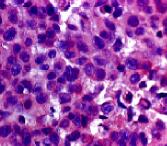| Reactivity | HuSpecies Glossary |
| Applications | WB, IHC |
| Clonality | Polyclonal |
| Host | Goat |
| Conjugate | Unconjugated |
| Concentration | LYOPH |
| Immunogen | Mouse myeloma cell line NS0-derived recombinant human SHBG Leu30-His402 Accession # P04278 |
| Specificity | Detects human SHBG in direct ELISAs and Western blots. |
| Source | N/A |
| Isotype | IgG |
| Clonality | Polyclonal |
| Host | Goat |
| Gene | SHBG |
| Purity Statement | Antigen Affinity-purified |
| Innovator's Reward | Test in a species/application not listed above to receive a full credit towards a future purchase. |
| Dilutions |
|
|
| Reviewed Applications |
|
|
| Publications |
|
| Storage | Use a manual defrost freezer and avoid repeated freeze-thaw cycles.
|
| Buffer | Lyophilized from a 0.2 μm filtered solution in PBS with Trehalose. *Small pack size (SP) is supplied either lyophilized or as a 0.2 µm filtered solution in PBS. |
| Preservative | No Preservative |
| Concentration | LYOPH |
| Reconstitution Instructions | Reconstitute at 0.2 mg/mL in sterile PBS. |
Human SHBG (also known as ABP or androgen-binding protein) is a variably glycosylated, secreted non-disulfide linked homodimer that belongs to the SHBG family. Members of this small family have tandem repeats of 170 amino acid (aa) long laminin alpha chain G-like domains. Each SHBG monomer is a 47-53 kDa, 373 aa glycoprotein that contains one steroid-binding site in its N-terminal G-like domain. Male and female sex hormones are bound with equal affinity. SHBG is synthesized by the liver and circulates in blood; ABP (SHBG in the testis) is synthesized by Sertoli cells and circulates in the male reproductive system. Human SHBG shares approximately 67% aa sequence identity with mouse and rat SHBG.
| Images | Ratings | Applications | Species | Date | Details | ||||||||
|---|---|---|---|---|---|---|---|---|---|---|---|---|---|

Enlarge |
reviewed by:
Verified Customer |
IHC-P | Human | 04/04/2020 |
Summary
|
Secondary Antibodies |
Isotype Controls |
The concentration calculator allows you to quickly calculate the volume, mass or concentration of your vial. Simply enter your mass, volume, or concentration values for your reagent and the calculator will determine the rest.